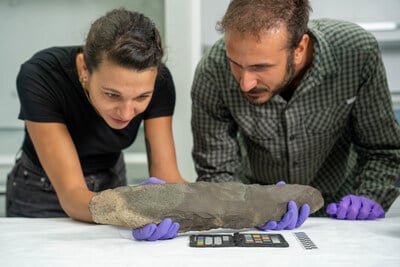Initial on-site research suggests that this huge fine-grained basalt tool is 20 inches long and is apparently the largest “hand ax” in the world. The artifact dates back to the Lower to Middle Paleolithic and is over 200,000 years old.
The hand ax was discovered by an international team of archaeologists working with the Royal Commission for AlUla (RCU), led by Dr. Omer “Can” Aksoy and Dr. Gizem Kahraman Aksoy from TEOS Heritage. The team explored a desert landscape south of AlUla, called the Qurh Plain, to look for evidence of human activity in ancient times.
The team has already managed to uncover archaeological artifacts that show that this forbidden land was home to a vibrant community in the early Islamic period, and now the discovery of this rare and unique object promises to open a new chapter in human history in Arabia and beyond to write out.
Made from fine-grained basalt, the stone tool is 20″ long and has been machined on both sides to create a sturdy tool with usable cutting or chopping edges. At this point, functionality can only be guessed at, but despite its size, the device fits comfortably in two hands.
The investigation is ongoing, and this find is just one of more than a dozen similar, albeit slightly smaller, Paleolithic hand axes that have been discovered. It is hoped that further scientific research will reveal more details about the origin and function of these items and the people who made them hundreds of thousands of years ago.
Dr. Ömer Aksoy, project leader, said:
“This hand ax is one of the most important finds in our ongoing survey of the Qurh Plain.”
GOT NEWS? click here
Google News, Bing News, Yahoo News, 200+ publications
“This amazing stone tool is more than half a meter long (length: 51.3 cm, width: 9.5 cm, thickness: 5.7 cm) and is the largest example of a series of stone tools discovered at this site. When searching for comparisons around the world, no hand ax of the same size was found. This could make it one of the largest hand axes ever discovered act.”
In addition to this survey of the Qurh Plain, the RCU is currently overseeing 11 other special archaeological projects being carried out in AlUla and nearby Khaybar. This ambitious research program is being carried out with the aim of further unraveling the mysteries of the ancient world in this region. This extraordinary discovery highlights how much there is still to learn about Saudi Arabia‘s human history.
Archeology is an essential element in the RCU’s comprehensive regeneration of the AlUla district as a world-leading cultural and natural heritage destination.
The 12 archaeological missions conducted during the fall 2023 season from October to December represent one of the world’s largest concentrations of archaeological research and conservation. Work will continue with additional missions planned in winter and spring 2024.
The fall 2023 season features a remarkable international gathering of more than 200 archaeologists and cultural heritage professionals, including experts from Australia, France, Germany, Italy, the Netherlands, Saudi Arabia, Switzerland, Syria, Tunisia, Turkey, and the United Kingdom. Many of the projects are a continuation of ongoing research that includes training and mentoring more than 100 archeology students from Saudi Arabia.
The first AlUla World Archeology Summit was held in September, highlighting AlUla’s position as a center of archaeological activity. The summit attracted more than 300 delegates from 39 countries and led to interdisciplinary conversations aimed at connecting archeology to larger communities.
SOURCE: Saudi Arabia Discovery in AlUla Rewriting History







